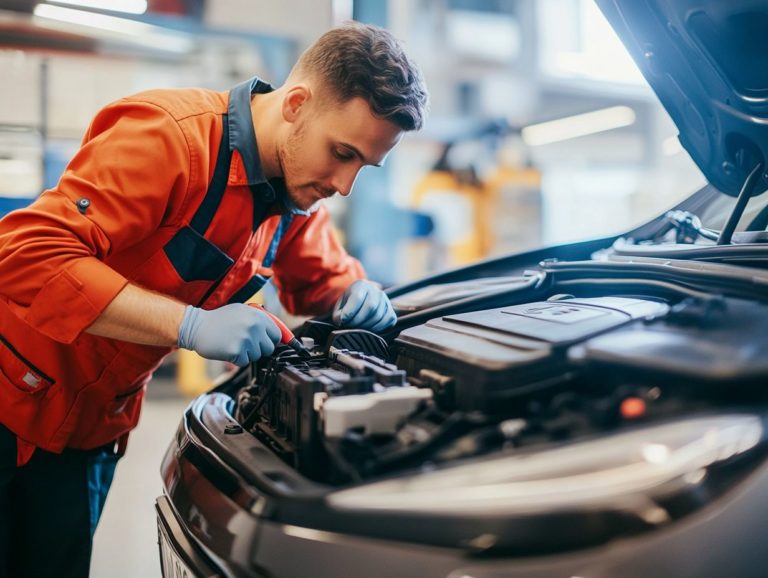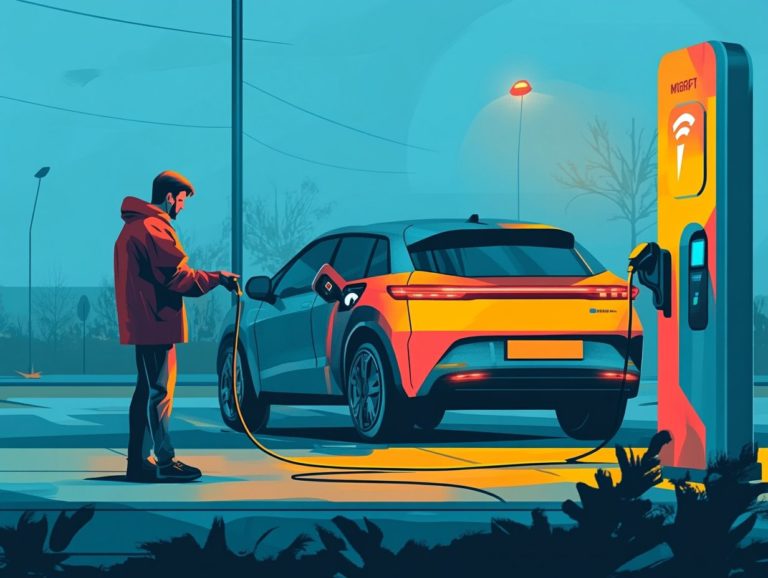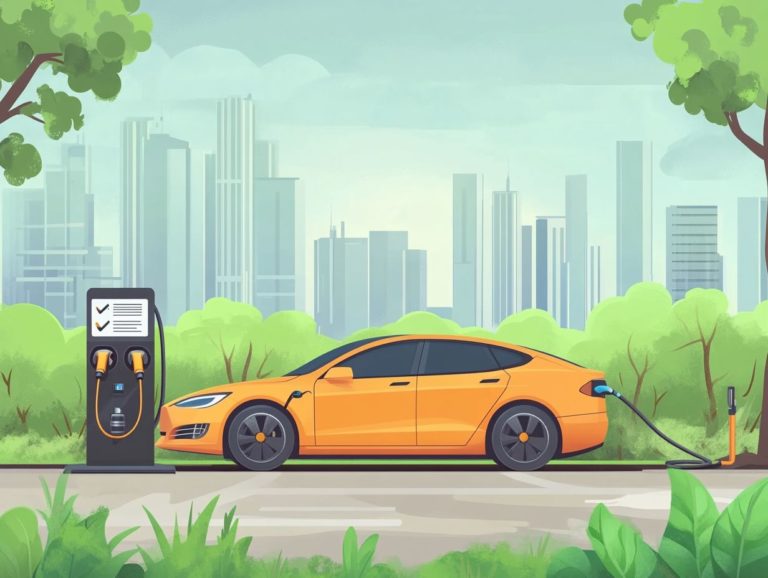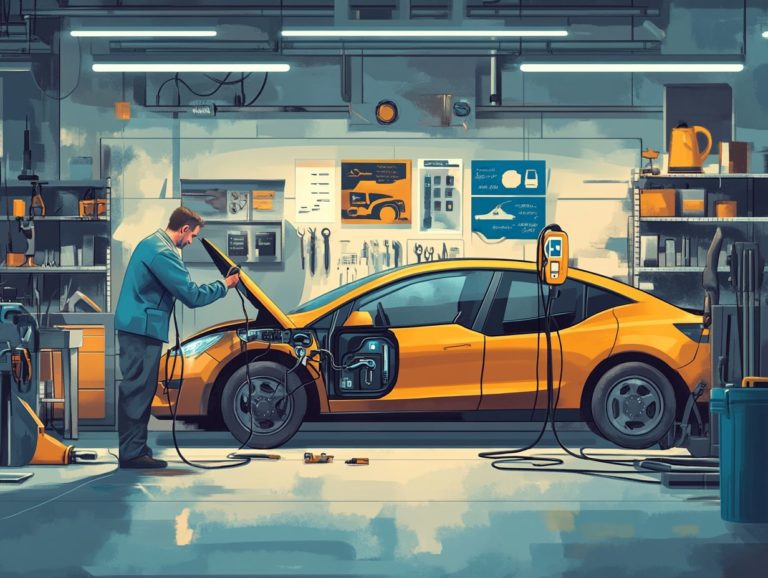Seasonal Checklist for Your Electric Vehicle
As the seasons shift, so do the demands of your electric vehicle. Keeping your EV in top shape boosts performance and ensures your safety on the road.
Check your tire health, battery status, and brakes regularly. This seasonal checklist covers all essential maintenance tasks every EV owner should prioritize.
Follow these simple steps to travel confidently, no matter the weather. Discover how to keep your electric vehicle running smoothly!
Contents
- Key Takeaways:
- 1. Check Your Tires
- 2. Test Your Battery
- 3. Inspect Your Brakes
- 4. Check All Lights and Signals
- 5. Top Off All Fluids
- 6. Clean and Wax Your Vehicle
- 7. Check Your Charging Cables
- 8. Test Your Heating and Cooling Systems
- 9. Check Your Wipers and Wiper Fluid
- 10. Inspect Your Suspension and Steering
- 11. Check for Any Recalls
- 12. Test Your Electric Range
- 13. Check Your Vehicle’s Software Updates
- 14. Inspect Your Charging Station
- 15. Create an Emergency Kit
- Frequently Asked Questions
- What is a seasonal checklist for your electric vehicle?
- Why is it important to have a seasonal checklist for your electric vehicle?
- What should be included in a seasonal checklist for your electric vehicle?
- When should I perform a seasonal checklist for my electric vehicle?
- Can I perform a seasonal checklist for my electric vehicle on my own?
- What are the benefits of following a seasonal checklist for your electric vehicle?
Key Takeaways:
- Check and maintain your tires regularly for safety and performance.
- Test your battery often and replace it if needed to avoid unexpected breakdowns.
- Inspect your brakes to ensure they are in good shape to keep you safe.
1. Check Your Tires
Checking your tires is essential for your electric vehicle’s safety and performance. Proper maintenance includes regular inspections of tire pressure and tread depth.
Do a tire pressure check at least once a month and before long trips. Use a quarter to measure tread depth; if it s 2/32 inches or more, you re good for wet conditions.
Worn tires can compromise traction and create dangerous situations. Adjust your vehicle settings based on different loads and conditions.
2. Test Your Battery
Testing your EV’s battery is vital for peak performance and longevity. Proper care prevents degradation over time.
Start with a visual check for swelling, leaks, or corrosion. These signs can indicate issues that need fixing.
Using battery diagnostic tools will give you insights into voltage and charge capacity. Regular checks help you spot degradation and maintain your vehicle’s efficiency.
3. Inspect Your Brakes
Checking your brakes ensures safe operation of your electric vehicle. Good brake maintenance prevents accidents and keeps your vehicle running efficiently.
Regularly examine your brake pads for wear; these are crucial for reliable stopping power. Also, check brake fluid levels to ensure they re within the recommended range.
Regenerative braking helps recharge your battery, extending its life. Always use a reliable jack and wear protective gear when inspecting brakes.
If you hear squeaking or feel pulsation, consult a professional for EV services.
4. Check All Lights and Signals
Checking all the lights and signals on your electric vehicle is an essential safety measure. It enhances your visibility and communication with other drivers. This step not only boosts your overall vehicle protection but also ensures you comply with traffic laws.
Properly functioning headlights are crucial, especially during adverse weather conditions like rain or fog, where visibility can drop significantly. Your taillights signal to vehicles behind you, while turn signals provide vital cues for lane changes and turns. These are critical for safe driving.
A quick inspection is all it takes: turn on each light to ensure they illuminate brightly. Check for any lights that don’t work and verify that the lenses are clean and clear. Overlooking these maintenance tasks could elevate your risk of accidents and expose you to potential legal repercussions or fines.
When driving at night, remember to reduce your speed and maintain a greater distance from other vehicles. This will give you ample reaction time in those low-light conditions.
5. Top Off All Fluids
Topping off all the fluids in your electric vehicle is crucial for keeping it running at its best. By ensuring systems like the coolant and brake fluid are functioning effectively, you’re enhancing your vehicle’s overall efficiency.
Checking these liquids can save you from costly repairs and help extend your vehicle’s lifespan. Check your coolant levels to prevent overheating, ensure the brake fluid is just right for optimal stopping power, and keep the windshield washer fluid filled for clear visibility during bad weather.
Maintaining these fluids not only supports peak performance but also guarantees that all systems run smoothly. For specific fluid specifications and maintenance schedules, consult your owner s manual for detailed guidance tailored to your vehicle’s make and model.
6. Clean and Wax Your Vehicle
Cleaning and waxing your electric vehicle isn t just about looking good; it s essential for protecting your investment from the elements, extending the life of the paint, and shielding the underlying components from harsh weather conditions.
To achieve the best results, adopt a step-by-step method. Start by choosing environmentally friendly cleaning products specifically formulated for electric vehicles. These products are typically free from harsh chemicals that could harm delicate surfaces.
Once you’ve thoroughly washed away dirt and grime, applying a high-quality wax will create a protective barrier. This routine does more than enhance your vehicle’s appearance; it also safeguards the paint from potential damage caused by UV rays, tree sap, and bird droppings.
Don t wait! Clean your vehicle regularly to keep it looking sharp. Incorporate this practice into your summer maintenance checklist to ensure your EV remains in pristine condition, ready to tackle any seasonal challenges that come its way.
7. Check Your Charging Cables
Regularly checking your electric vehicle’s charging cables is essential for ensuring a seamless charging experience and preventing electrical issues that might compromise your vehicle’s performance.
By taking a closer look at the cables, you can spot any signs of wear, such as fraying, cracks, or kinks that may develop over time. Check for visible cuts or wear on the cables. Choosing charging stations that are compatible with your vehicle is key to maximizing charging efficiency.
When selecting cables, be sure to choose ones that carry safety labels, indicating reliability and safety. It’s also wise to store your cables neatly when not in use coiled up without tight bends and away from extreme temperatures that could cause further damage.
Regular maintenance not only extends the life of your charging equipment but also ensures that your charging experience remains hassle-free. Keep your EV in top shape by following these tips!
8. Test Your Heating and Cooling Systems
Testing your electric vehicle’s heating and cooling systems is crucial to ensure you’re always ready to hit the road! This not only keeps you comfortable behind the wheel but also cools the battery that powers your electric vehicle, especially in extreme temperatures.
Making sure these systems function properly helps maintain battery performance and provides a pleasant driving experience in any weather.
To start your testing:
- Turn on the air conditioning and check if cold air circulates effectively through the vents.
- Switch to the heating function and see if warm air flows consistently.
Regular checks help you avoid unwelcome surprises during sweltering summers or frigid winters, enhancing your vehicle’s overall efficiency and protecting its electric components from overheating or freezing.
9. Check Your Wipers and Wiper Fluid
Ensuring that your vehicle’s wipers and wiper fluid are in optimal condition is essential for visibility during bad weather critical for your safety as an electric vehicle owner.
To determine if your wipers are showing signs of wear:
- Inspect the rubber blades for cracks, tears, or stiffness.
- If you notice any imperfections, replace them for a clear view in rain, snow, or fog.
Maintaining a sufficient level of wiper fluid is equally important, as it helps remove grime, dirt, and bugs that obstruct your line of sight.
In heavy rain or snow, your wipers are your best friends! They help you see clearly and drive safely. Always drive with caution in such weather and consider increasing your following distance to give yourself ample time to react to changing road conditions.
10. Inspect Your Suspension and Steering
Inspecting your electric vehicle’s suspension and steering systems is vital for ensuring safety and stability while driving, as these components play a crucial role in overall performance.
Regular inspections allow you to catch potential issues early, preventing them from becoming serious problems and ensuring a smoother ride with superior handling.
During your assessments, look for:
- Uneven tire wear
- Loose joints
- Worn bushings
These signs can indicate that your steering or suspension components are starting to fail. Compromised systems can diminish braking efficiency and lead to poor alignment, affecting how your vehicle handles.
Stay alert to any unusual noises or steering vibrations while driving. Don t hesitate to schedule a professional inspection if you notice anything amiss.
11. Check for Any Recalls
Checking for any recalls on your electric vehicle is an essential step to ensure safe and reliable operation. It can reveal critical issues that need your immediate attention, protecting both your safety and the longevity of your vehicle.
To perform this check effectively:
- Visit the manufacturer’s website or the National Highway Traffic Safety Administration (NHTSA) portal.
- Enter your Vehicle Identification Number (VIN), which is a unique number that identifies your vehicle and helps check for recalls.
Addressing recall notices promptly is crucial; unresolved issues can lead to safety hazards or increased repair costs.
Don t wait! Check for recalls today to ensure your vehicle is safe. Having a vehicle protection plan provides peace of mind, ensuring any necessary repairs from a recall are covered, significantly alleviating the financial burden you might face.
12. Test Your Electric Range
Testing your electric vehicle’s range is crucial for planning long journeys. Understanding how various driving conditions affect battery performance ensures you maximize your vehicle’s efficiency.
To assess your electric range effectively, take advantage of built-in vehicle settings that provide real-time data. You can also use specialized mobile apps designed for tracking energy consumption. These resources offer valuable insights into your remaining battery life and estimated range based on your driving habits.
Keep in mind that factors like aggressive acceleration, sudden stops, and different terrain can significantly impact your range. Extreme weather whether hot or cold can also reduce battery performance.
To optimize your electric range, maintain a steady driving speed. Use regenerative braking, which helps recharge your battery when slowing down, and precondition your vehicle while it s plugged in. These strategies will enhance your efficiency and make every trip smoother.
13. Check Your Vehicle’s Software Updates
Regularly checking for software updates on your electric vehicle is essential for boosting its performance. Manufacturers frequently release updates that enhance performance and address potential issues.
By staying updated, you ensure that your vehicle operates at peak efficiency and can fully leverage the latest technological advancements. To check for updates, navigate to the vehicle’s settings via the infotainment system or mobile app, where notifications about available updates are typically displayed.
Installing these updates optimizes performance and upholds the highest safety standards. Features such as advanced driver assistance systems rely on the latest software, improving response times and overall driving reliability.
14. Inspect Your Charging Station
Inspecting your electric vehicle’s charging station is a vital maintenance step. This ensures that your charging process remains both efficient and safe, helping you avoid potential electrical issues.
Dedicate a few moments to thoroughly examine each component. Spot any signs of wear, damage, or dirt that might hinder functionality. Begin by assessing the physical condition of the station; look for visible cracks, frayed cables, or signs of corrosion.
Next, inspect the connectors to ensure they are clean and free from debris. Even minor contaminants can disrupt the charging process. Once you’ve completed the visual inspection, it s essential to test the electrical components. If you encounter malfunctions, troubleshooting common charging issues like resetting the station or checking the power source can often resolve the problem swiftly.
15. Create an Emergency Kit
An emergency kit is a must-have for your electric vehicle! Be ready for any surprises on your journey, especially during road trips or adverse weather.
Whether you face a tire blowout, a dead battery, or find yourself caught in a sudden storm, a well-stocked emergency kit can be a game-changer. For electric vehicle owners, this kit should ideally include:
- first-aid supplies
- basic tools for minor repairs
- essential charging cables or adapters to keep your power flowing
Don t forget to pack items like a flashlight, water, and non-perishable snacks to address both immediate and basic needs during unforeseen delays.
Don t wait! Assemble your emergency kit now and drive with confidence, knowing you re prepared for anything!
Frequently Asked Questions
What is a seasonal checklist for your electric vehicle?
A seasonal checklist for your electric vehicle is a list of maintenance tasks and preparations that should be done at the change of each season to ensure optimal performance and longevity of your vehicle.
Why is it important to have a seasonal checklist for your electric vehicle?
A seasonal checklist for your electric vehicle is essential and can be found in the ultimate checklist for EV buyers. It helps identify and fix potential issues before they escalate.
What should be included in a seasonal checklist for your electric vehicle?
Include tasks like checking tire pressure, inspecting the battery, and testing brakes. Prepare for extreme weather that affects vehicle performance.
When should I perform a seasonal checklist for my electric vehicle?
Perform your checklist at the start of each season. This ensures your vehicle is ready for weather changes and different driving habits.
Can I perform a seasonal checklist for my electric vehicle on my own?
You can handle some tasks yourself. However, it’s best to have a professional inspect your electric vehicle for potential issues.
What are the benefits of following a seasonal checklist for your electric vehicle?
Following a seasonal checklist boosts your vehicle’s performance and efficiency. It reduces breakdown risks and saves money on repairs.






